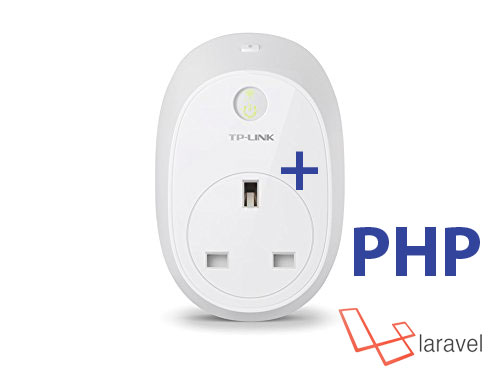williamson / tplinksmartplug
A PHP library to control and receive information from a TP-Link smartplug.
Installs: 1 813
Dependents: 0
Suggesters: 0
Security: 0
Stars: 13
Watchers: 3
Forks: 7
Open Issues: 2
pkg:composer/williamson/tplinksmartplug
Requires
- tightenco/collect: ^5.3
Requires (Dev)
- phpunit/phpunit: ^5.7
This package is auto-updated.
Last update: 2025-11-27 00:16:30 UTC
README
###(Bonus Laravel integration supported!!)
TPLink Smartplug is a small PHP library that allows anyone to control and access a TPLink Smartplug.
Current TPLINK models supported are
It is likely that other TPLink models will also work, but these have not been checked.
Installation
This package can be installed standalone in a regular PHP project, or can also be integrated into Laravel to make life even easier.
To install the latest version simply use composer to add it to your project using the following command:
composer require williamson/tplinksmartplug
Laravel Installation/Integration
This library supports Laravel's auto discovery feature for auto registering the service provider and facade. If your version of Laravel supports auto discovery, after you have added this package YOU ARE NOW DONE!
If you are using a very old version of Laravel, once this package is installed, you need to register the package's service provider, in config/app.php:
'providers' => [ //... Williamson\TPLinkSmartplug\Laravel\TPLinkServiceProvider::class, ]
Facades
Only if your version of Laravel does NOT support auto discovery then add the following to the aliases section of 'app.php'.
'aliases' => [ //... "TPLink" => Williamson\TPLinkSmartplug\Laravel\Facades\TPLinkFacade::class ]
Config file
This package requires a config file so that you can provide the address/details of the TPLink devices you would like to control. To generate this file, run the following command:
$ php artisan vendor:publish --provider='Williamson\TPLinkSmartplug\Laravel\TPLinkServiceProvider'
This will create a TPLink.php file in your Laravel config folder. You should edit this to setup your devices.
Configuration
The config file is a very simple array structured file. A config file is required for both standalone/Laravel projects. The content is similar to this:
//TPLink.php <?php return [ 'lamp' => [ 'ip' => '192.168.1.100', //Or hostname eg: home.example.com 'port' => '9999', ], ];
You may add as many devices as you wish, as long as you specify the IP address (or host address if required) and port number to access each one. Giving each device a name makes it easy to identify them when coding later. (Please note that the name you give here does NOT have to match the actual name you might have assigned the device using an official app like Kasa. They do NOT have to match)
Usage
You can access your device either through the TPLinkManager class (especially useful if you have multiple devices), or directly using the TPLinkDevice class.
Using the manager, allows you to specify WHICH device you would like to send your command to.
If you only have one device you may just want to use the TPDevice class by itself - but using the manager is recommended.
Depending on your style of coding you may use either the Facade or instantiate the object yourself.
The following are all similar:
//Non laravel $tpManager = new TPLinkManager($configArray); $tpDevice = $tpManager->device('lamp') //Laravel //with facade TPLink::device('lamp') //without facade $tpDevice = app('tplink')->device('lamp'); $tpDevice = app(TPLinkManager::class)->device('lamp');
Once you have your device ready, you can then send it a command.
Commands
All commands for the smartplug have been created in a separate class to ease use and allow for more to be added easily in the future.
To send a command, simply call the sendCommand method on the TPDevice object and pass in the command required as a parameter.
For example, to get the current status of the smartplug
//Non laravel $tpDevice->sendCommand(TPLinkCommand::systemInfo()); //Laravel //with facade TPLink::device('lamp')->sendCommand(TPLinkCommand::systemInfo()); //without facade $tpDevice->sendCommand(TPLinkCommand::systemInfo());
If a command requires a parameter, provide that as well:
//Non laravel $tpDevice->sendCommand(TPLinkCommand::setLED(false)); //Laravel //with facade TPLink::device('lamp')->sendCommand(TPLinkCommand::setLED(false)); //without facade $tpDevice->sendCommand(TPLinkCommand::setLED(false));
####Toggle Power
There is one command that is called directly on the TPLinkDevice and that is the togglePower() method.
If you only wish to toggle the current power state of the plug, use it as follows:
//Non laravel $tpDevice->togglePower(); //Laravel //with facade TPLink::device('lamp')->togglePower(); //without facade $tpDevice->togglePower();
There are a large number of commands in the TPLinkCommand class. Please read the docblock comments for explanations and requirements for each one.
The current list of commands available to use are:
systemInfo
powerOn
powerOff
setLED
setDeviceAlias
setMacAddress
setDeviceId
setHardwareId
setLocation
checkUboot
getDeviceIcon
getDownloadState
checkConfig
flashFirmware
downloadFirmware
setTestMode
reboot
reset
cloudInfo
cloudFirmwareList
cloudSetServerUrl
cloudConnectWithAccount
cloudUnregisterDevice
wlanScan
wlanConnectTo
getTime
getTimezone
setTimeAndTimeZone
emeterRealtimeReading
emeterGainSettings
emeterSetGains
emeterStartCalibration
emeterStatsMonth
emeterStatsYear
emeterStatsWipeAll
scheduleNext
scheduleRuleList
scheduleRuleCreate
scheduleRuleEdit
scheduleRuleDelete
scheduleRuleWipeAll
scheduleRuntimeStatsWipeAll
countdownRuleList
countdownRuleCreate
countdownRuleEdit
countdownRuleDelete
countdownRuleWipeAll
antitheftRuleList
antitheftRuleCreate
antitheftRuleEdit
antitheftRuleDelete
antitheftRuleWipeAll
Additional information
Any issues, feedback, suggestions or questions please use issue tracker here.
Credits
- softScheck (Who did the reverse engineering and provided the secrets on how to talk to the Smartplug.)
- Jonathan Williamson
- Syed Irfaq R. For the idea behind how to manage multiple devices.
Disclaimer
This project and its author is neither associated, nor affiliated with TP-LINK in anyway. See License section for more details.
License
This project is released under the MIT License.
© 2017 Jonathan Williamson, All rights reserved.

